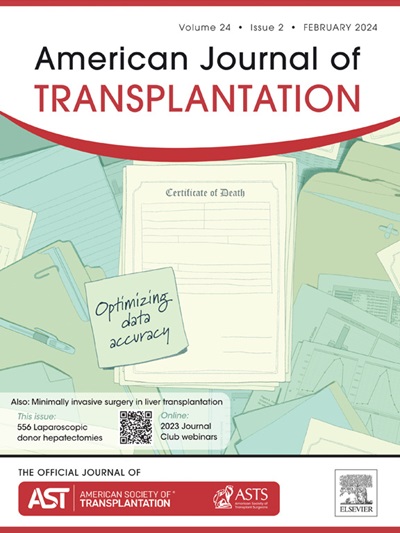针对 BK 多瘤病毒 VP1 的新型人源单克隆中和抗体 MAU868 的非临床和临床特征。
IF 8.9
2区 医学
Q1 SURGERY
引用次数: 0
摘要
BK 多瘤病毒(BKPyV)再活化可导致免疫力低下的患者出现严重的肾脏和膀胱疾病。目前还没有有效的 BKPyV 特异性疗法。MAU868 是一种新型人类 IgG1 单克隆抗体,能以皮摩尔级的亲和力与 BKPyV 的主要囊膜蛋白 VP1 结合,中和四种主要 BKPyV 基因型的感染(EC50 从 0.009 到 0.093 μg/ml;EC90 从 0.102 到 4.160 μg/ml),并对 VP1 多态性高度流行的变体具有类似的活性。在长期选择研究中未发现与耐药性相关的变异体,表明其体外耐药性屏障很高。MAU868 与 VP1 五聚体复合物的高分辨率晶体结构确定了 VP1 中的三个关键接触残基(Y169、R170 和 K172)。我们首次开展了一项人体研究,采用随机、安慰剂对照、双盲、单剂量递增的设计,对健康成人静脉注射和皮下注射 MAU868 后的安全性、耐受性和药代动力学进行了评估。MAU868的安全性和耐受性良好。所有不良反应均为1级并已缓解。MAU868 的药代动力学与人类 IgG 相似,全身暴露量与剂量成正比,消除半衰期为 23 至 30 天。这些结果证明了 MAU868 作为治疗或预防 BKPyV 疾病的第一类治疗药物的潜力。本文章由计算机程序翻译,如有差异,请以英文原文为准。
Nonclinical and clinical characterization of MAU868, a novel human-derived monoclonal neutralizing antibody targeting BK polyomavirus VP1
Reactivation of BK polyomavirus (BKPyV) can cause significant kidney and bladder disease in immunocompromised patients. There are currently no effective, BKPyV-specific therapies. MAU868 is a novel, human immunoglobulin (Ig) G1 monoclonal antibody that binds the major capsid protein, VP1, of BKPyV with picomolar affinity, neutralizes infection by the 4 major BKPyV genotypes (EC50 ranging from 0.009-0.093 μg/mL; EC90 ranging from 0.102-4.160 μg/mL), and has comparable activity against variants with highly prevalent VP1 polymorphisms. No resistance-associated variants were identified in long-term selection studies, indicating a high in vitro barrier-to-resistance. The high-resolution crystal structure of MAU868 in complex with VP1 pentamer identified 3 key contact residues in VP1 (Y169, R170, and K172). A first-in-human study was conducted to assess the safety, tolerability, and pharmacokinetics of MAU868 following intravenous and subcutaneous administration to healthy adults in a randomized, placebo-controlled, double-blinded, single ascending dose design. MAU868 was safe and well-tolerated. All adverse events were grade 1 and resolved. The pharmacokinetics of MAU868 was typical of a human IgG, with dose-proportional systemic exposure and an elimination half-life ranging between 23 and 30 days. These results demonstrate the potential of MAU868 as a first-in-class therapeutic agent for the treatment or prevention of BKPyV disease.
求助全文
通过发布文献求助,成功后即可免费获取论文全文。
去求助
来源期刊
CiteScore
18.70
自引率
4.50%
发文量
346
审稿时长
26 days
期刊介绍:
The American Journal of Transplantation is a leading journal in the field of transplantation. It serves as a forum for debate and reassessment, an agent of change, and a major platform for promoting understanding, improving results, and advancing science. Published monthly, it provides an essential resource for researchers and clinicians worldwide.
The journal publishes original articles, case reports, invited reviews, letters to the editor, critical reviews, news features, consensus documents, and guidelines over 12 issues a year. It covers all major subject areas in transplantation, including thoracic (heart, lung), abdominal (kidney, liver, pancreas, islets), tissue and stem cell transplantation, organ and tissue donation and preservation, tissue injury, repair, inflammation, and aging, histocompatibility, drugs and pharmacology, graft survival, and prevention of graft dysfunction and failure. It also explores ethical and social issues in the field.

 求助内容:
求助内容: 应助结果提醒方式:
应助结果提醒方式:


